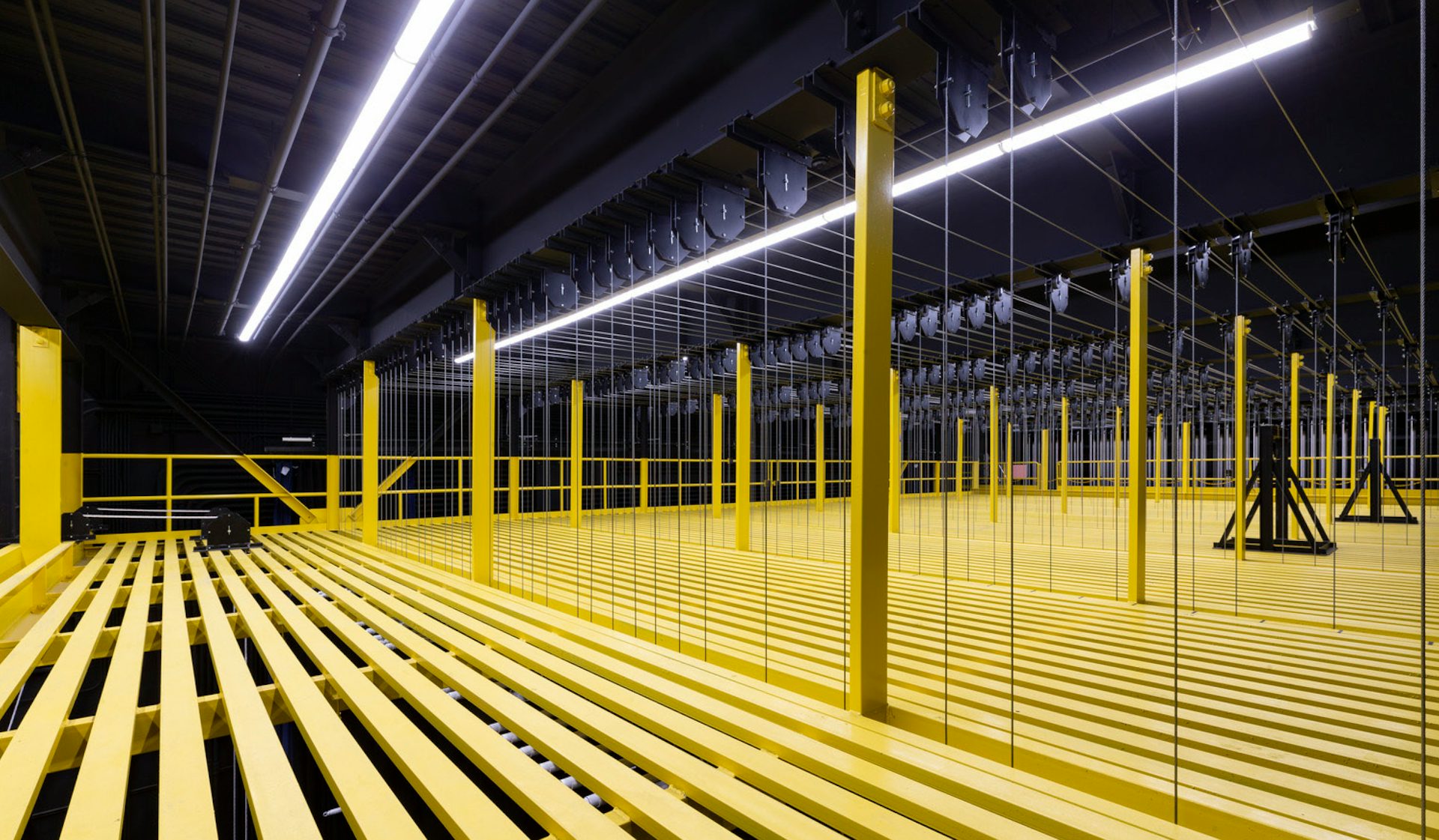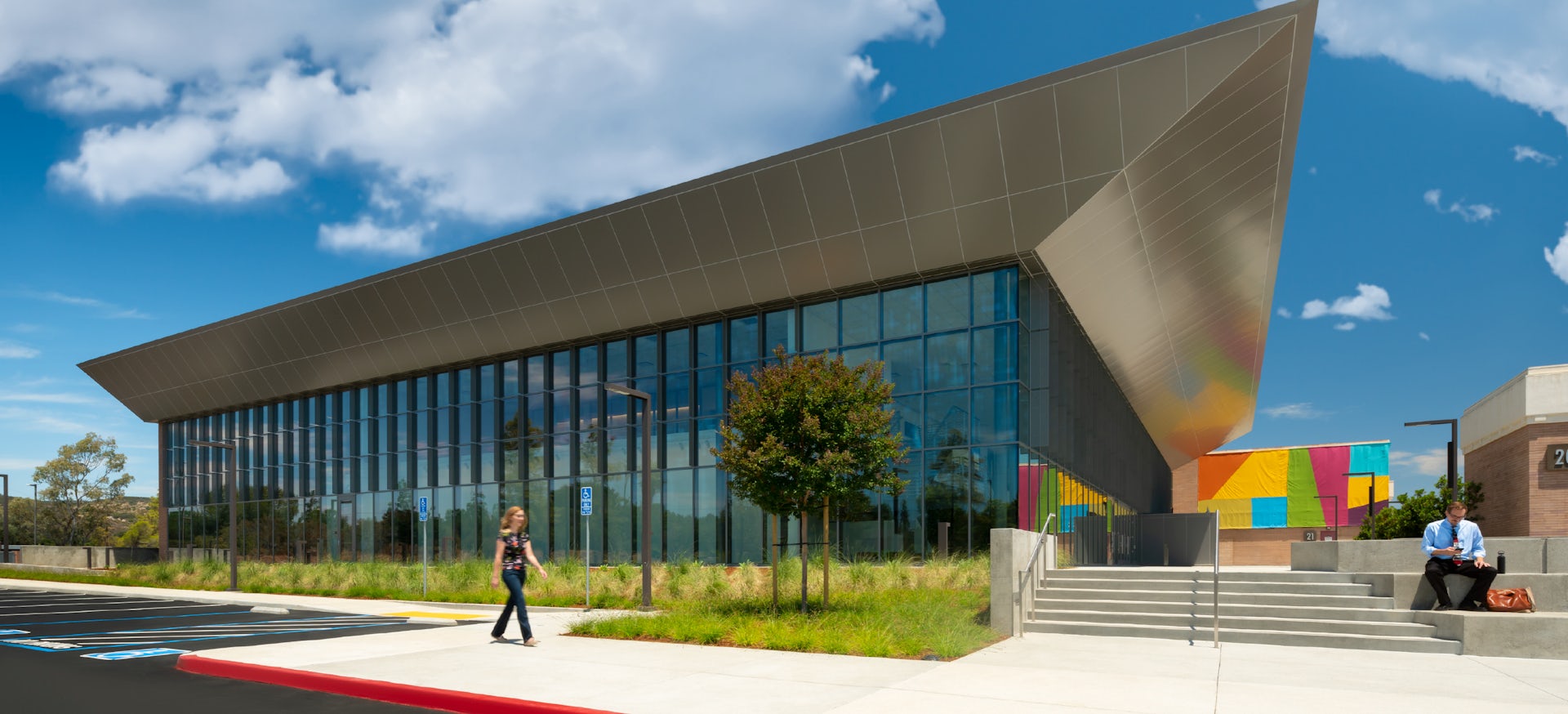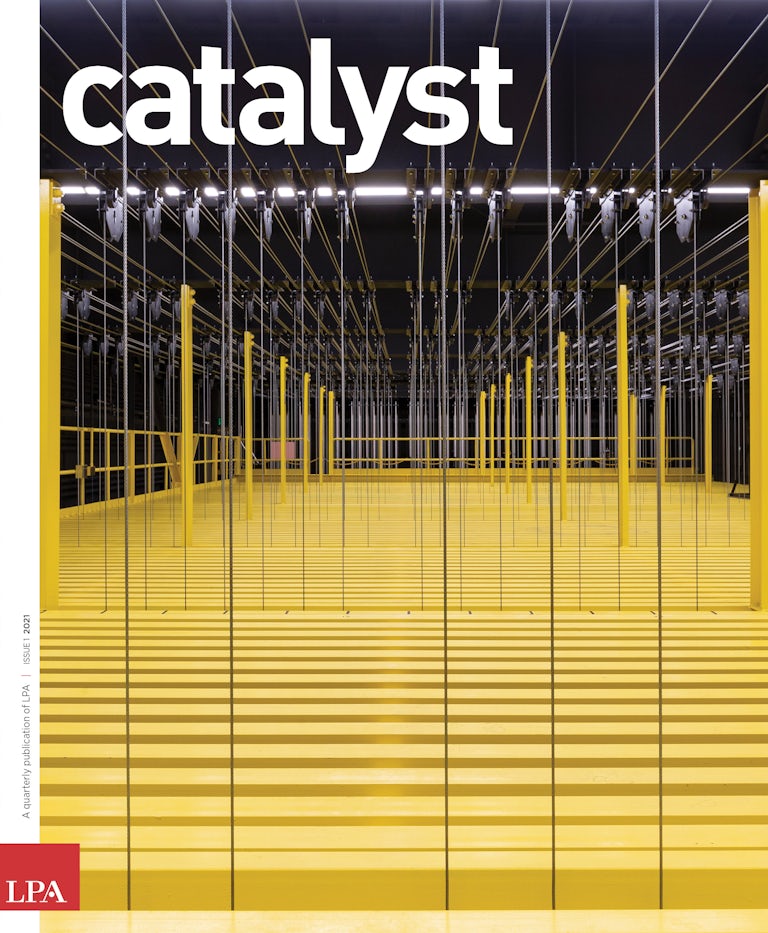The new 390-seat Grossmont College Performing & Visual Arts Center is designed to be adaptable. It maximizes space to serve as a valuable theater for the El Cajon, California, campus and community, while serving many roles for the community college’s burgeoning arts program.
The $36-million facility includes a large versatile stage, orchestra pit and balcony, as well as exhibition space for the college’s young artists. The design, developed after a lengthy engagement process with all stakeholders, accommodates a wide variety of disciplines, including dance, music and theater.
Teaching Performance
The new Grossmont College Performing & Visual Arts Center plays multiple roles as a theater and a teaching tool for students.

At the same time, the facility is a flexible teaching space, supporting programs that prepare students for careers in the performing arts.
“When the lights are on, it’s for students to learn how a theater works,” says LPA Design Director Silke Frank. “When the lights are off, it’s about performance.”
It was a challenge to create a space shared by so many different artists and stakeholders; each group’s performance and audience needs something different to excel. Everyone is “fighting for their own space,” says LPA Project Manager Steve Lathus.



In addition to accommodating the diverse education and performance needs of the growing performing arts program, the new Grossmont Performing Arts Center is designed to cut energy use and conserve water.
1. The sun shades diffuse sunlight and protect the interiors from solar gain.
2. The unique roof design provides overhang protection to the spaces below.
3. The roof also serves to collect and channel rainwater into a collection system.
4. A percolation tank collects rainwater and gradually releases it back into the ground.
5. The efficient, low-velocity HVAC system is specifically designed to minimize disruptions during performances.
...
The professional-quality stage is a workhorse, serving multiple training, education and performance needs. If needed, additional seating can slide out from under the stage, filling in the orchestra pit and placing theatergoers next to performers. In addition, an apron can expand the stage for dance performances, with a portable, resilient floor on rollers that can be stored in a separate room when not in use. Adjustable acoustical elements and curtains above and around seating can also be rearranged to create the desired auditory setting.
The building’s small footprint forced designers to go vertical, and that design choice served the needs of performers and audiences. The taller, rectangular main theater, coated in undulating, angular acoustic panels and multicolor LED lights, forms a chamber that increases reverberation and improves sound quality during musical performances. The vertical dimensions also offered space for mid-tier balcony seating, which provides a more intimate experience for audience members. The compact design balances the mechanics of sound and the connection between actors and audience.
Every opportunity is taken to link the spaces with teaching opportunities, to help students develop the skills and experience necessary to work in a professional theater.
With this facility, we are sending the message to the community that, in addition to being a fantastic place of learning, we are a house for the arts in East County.

Elements are colorized and layered to make them stand out for lessons. Mechanical pulls on the rigging, the accessible catwalk and easily adaptable lighting stations allow students to get firsthand experience in the nuts and bolts of production.
“We wanted to make the theater as adjustable as possible,” Frank says. “Every space is a teaching space.”
The theater location, on a small former parking lot near the campus entrance, provided the opportunity to create a new gateway for the college. The glass walls and angular roofline became focal points without overshadowing more established buildings. During construction, Grossmont College President Nabil Abu-Ghazaleh, now retired, called the facility the college’s new “front door.”
“With this facility, we are sending the message to the community that, in addition to being a fantastic place of learning, we are a house for the arts in East [San Diego] County,” he said.
The theater’s glazed exterior displays the interior lobby, which can double as a gallery and event space. Bricks and plaster serve as connective tissue to the more traditional architecture on campus, with the new arts center linking to a neighboring structure.
“The building is different from the other ones on campus,” says LPA Managing Director Young Min. “It’s dramatic but calls back to the vernacular language on campus.”
Every inch of the facility can play multiple roles and support the diversity of the school’s talent. The flexibility will also help the school’s growing arts program connect with the wider campus and the local audience, making the theater an important new asset for the community.
...
An Extraordinary Theater on an Ordinary Budget
A performing arts center facility can play many valuable roles on a campus, serving students and the community. On every project, the challenge is to stretch dollars and maximize the value of the facility, even when the budget is tight and space is limited. Catalyst talked to LPA Project Designer Emily Koch, a veteran of many campus theater projects, about how to get the most bang for the buck to create an extraordinary, long-lasting theater facility.
1. Research pays dividends. “It’s important to coordinate the facility to perform at a high level for a variety of different groups and a variety of different activities,” Koch says. That’s hard to do in a performing arts environment, when you want the theater to perform, in many cases, vastly different functions. The process needs to start with a deep exploration of the stakeholders and their needs, Koch says.
2. Pay attention to acoustics. Providing variable acoustics in a space is essential to create flexibility. Drapes or curtains that are either manually moved or motorized can create new performance spaces for specific activities. Curtains can deaden the space to program smaller voice or spoken-word performances or be raised for string or other music performances.
3. Activate rehearsal spaces. In many departments, the stage or rehearsal space doubles as a classroom. “Having good teaching light and working light that’s separate from performance lighting is sometimes overlooked,” Koch says. The rehearsal space in the East Central High School Performing Arts Center is a copy of the main stage, increasing the flexibility and value when other productions are using the theater. The space is used for dance, as well as theater and music rehearsals. It also has the bonus of natural light, which is ideal for a general classroom setting, as well as theatrical lighting for smaller performances.
4. Don’t skimp on storage. Storage space is often removed in the process, but it can play an important role in maximizing usage. Multiple groups can use a stage, when it is easy to store sets and equipment offstage, Koch says. A dedicated, climate-controlled piano storage area means you don’t have to always move a grand piano from another building or another room. Large wing spaces can accommodate an orchestra shell, which will allow the stage to be easily converted for concerts.
5. Consider the community. Many schools are looking to lend out their buildings to community groups. “We’ve been building in pre-function rooms with space that can be easily used for meetings or events,” Koch says. “It’s like a plug-and-play sort of room that has power, a sink, a refrigerator and a spot for a TV.” Thoughtful planning can turn formerly underutilized spaces, such as lobbies, into valuable resources for conferences and community affairs.
6. Think outside the box. The traditional model for a theater is not always the best. For El Rancho High School, instead of permanent, elevated seating, the theater was left as a flat form with flexible tiered seating that could be retracted for different performances. “The space can be easily adapted for theater in the round or different events, which really suited the district’s needs,” Koch says. “It allows more audience participation and more community participation versus just having everyone static in seats that can never move.”

7. Find the space. It’s always a challenge to accommodate different needs into a confined space, Koch says. Sometimes it takes focus and compromise to find solutions that service the larger goal. For Milpitas High School, north of San Jose, a constrained space was addressed by an underground space and narrow hallways that wrap around the larger stage openings and dressing rooms. “They gave up a little bit of the circulation for having multilevel and larger stage space,” Koch says.
8. Focus on multiple uses. “We’re always thinking of a variety of uses for every space,” Koch says. Even the dressing rooms can be designed with flexibility to accommodate different needs. Not every production needs equal size men’s and women’s dressing rooms. Competitions and community events have their own requirements. “Building in the capability to remove hair and makeup or adding showers or deep sinks so it’s not just a clothing change space can make those spaces much more useful,” Koch says. “We are always looking for the dual uses and the year-round opportunities that can be found in these spaces.”















